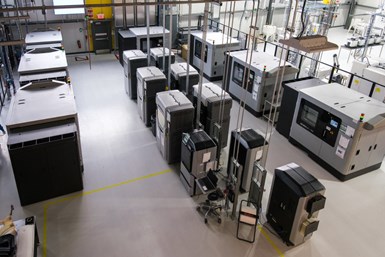GM Opens Additive Industrialization Center Dedicated to 3D Printing
3D printing will help transform GM operations in product development, motorsports and manufacturing.

General Motors’ AIC includes 24 3D printers, which create polymer and metal solutions using a variety of processes.
General Motors’ new 15,000-square-foot Additive Industrialization Center (AIC) is dedicated to productionizing 3D printing technology in the automotive industry. “The core component of GM’s transformation is becoming a more agile, innovative company, and 3D printing will play a critical role in that mission,” says Audley Brown, GM director of Additive Design and Materials Engineering. “Compared to traditional processes, 3D printing can produce parts in a matter of days versus weeks or months at a significantly lower cost.”
The facility includes 24 3D printers, which create polymer and metal solutions using a variety of processes, including selective laser sintering, selective laser melting, Multi Jet Fusion and fused deposition modeling. The AIC is intended to validate additive technologies and applications, with frequent pivots to evolving additive machinery and equipment. GM Ventures and GM R&D are collaborative partners with the AIC to support an integrated enterprise approach to adopting accelerated product development and tooling.
“GM is increasingly applying the benefits of 3D printing, from prototype development to manufacturing tooling and production vehicles,” says Ron Daul, GM director of Additive Manufacturing and Polymer Centers. “With the opening of the AIC, we’ll continue to accelerate adoption of this technology across the organization.”
GM has a history of using 3D-printed rapid prototypes to check form and fit. Today, many of the parts the AIC produces are functional prototypes used on preproduction vehicles in various testing environments.
3D printing functional prototypes can help eliminate expensive early tooling costs. As a result, engineers have the ability to iterate quickly, make design changes and reduce development times. For example, the team 3D printed the brake cooling ducts used for the development of the Chevrolet Corvette, saving nine weeks of development and reducing costs by over 60% in the process.
GM is also producing a significant number of 3D-printed tools used for assembling vehicles. 3D printing often enables the team to consolidate the components of a part into a single, optimized design. The result is tools that are lighter, more ergonomic and less complex.
Related Content
-
VulcanForms Is Forging a New Model for Large-Scale Production (and It's More Than 3D Printing)
The MIT spinout leverages proprietary high-power laser powder bed fusion alongside machining in the context of digitized, cost-effective and “maniacally focused” production.
-
3D Printing with Plastic Pellets – What You Need to Know
A few 3D printers today are capable of working directly with resin pellets for feedstock. That brings extreme flexibility in material options, but also requires greater knowledge of how to best process any given resin. Here’s how FGF machine maker JuggerBot 3D addresses both the printing technology and the process know-how.
-
At General Atomics, Do Unmanned Aerial Systems Reveal the Future of Aircraft Manufacturing?
The maker of the Predator and SkyGuardian remote aircraft can implement additive manufacturing more rapidly and widely than the makers of other types of planes. The role of 3D printing in current and future UAS components hints at how far AM can go to save cost and time in aircraft production and design.













